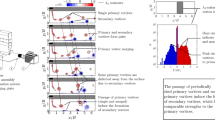Abstract
A pulsed jet with a period of no flow between pulses (i.e., a fully pulsed jet) produces a multiplicity of vortex rings whose characteristics are determined by the jet pulsing parameters. The present study analyzes the case of impulsively initiated and terminated jet pulses in the limit of equal pulse duration and period to determine the minimum possible vortex ring separation obtainable from a fully pulsed jet. The downstream character of the flow is modeled as an infinite train of thin, coaxial vortex rings. Assuming inviscid flow and matching the circulation, impulse, kinetic energy, and frequency of the jet and vortex ring train allow the properties of the vortex ring train to be determined in terms of the ratio of jet slug length-to-diameter ratio (L/D) used for each pulse. The results show the minimum ring separation may be made arbitrarily small as L/D is decreased and the corresponding total ring velocity remains close to half the jet velocity for L/D < 4, but the thin-ring assumption is violated for L/D > 1.5. The results are discussed in the context of models of pulsed-jet propulsion.
Similar content being viewed by others
References
Bremhorst K., Hollis P.G.: Velocity field of an axisymmetric pulsed, subsonic air jet. AIAA J. 28, 2043–2049 (1990)
Choutapalli, I.M.: An experimental study of a pulsed jet ejector. Ph.D. Dissertation, Florida State University, Tallahassee, FL (2006)
Fraenkel L.E.: Examples of steady vortex rings of small cross-section in an ideal fluid. J. Fluid Mech. 51, 119–135 (1972)
Gharib M., Rambod E., Shariff K.: A universal time scale for vortex ring formation. J. Fluid Mech. 360, 121–140 (1998)
Krueger P.S., Gharib M.: The significance of vortex ring formation to the impulse and thrust of a starting jet. Phys. Fluids 15, 1271–1281 (2003)
Krueger P.S., Gharib M.: Thrust augmentation and vortex ring evolution in a fully pulsed jet. AIAA J. 43, 792–801 (2005)
Lamb H.: Hydrodynamics, pp. 236–239. Dover, New York (1932)
Levy H., Forsdyke A.G.: The stability of an infinite system of circular vortices. Proc. R. Soc. London A 114, 594–604 (1927)
Mohseni K., Gharib M.: A model for universal time scale of vortex ring formation. Phys. Fluids 10, 2436–2438 (1998)
Reynolds W.C., Parekh D.E., Juvet P.J.D., Lee M.J.D.: Bifurcating and blooming jets. Annu. Rev. Fluid Mech. 35, 295–315 (2003)
Shariff, K., Leonard, A., Ferziger, J.H.: Dynamics of a class of vortex rings. NASA TM-102257 (1989)
Shariff K., Leonard A.: Vortex rings. Annu. Rev. Fluid Mech. 24, 235–279 (1992)
Siekmann J.: On a pulsating jet from the end of a tube, with application to the propulsion of certain aquatic animals. J. Fluid Mech. 15, 399–418 (1963)
Taylor G.I.: Formation of a vortex ring by giving an impulse to a circular disk and then dissolving it away. J. Appl. Phys. 24, 104 (1953)
Vermeulen P.J., Rainville P., Ramesh V.: Measurements of the entrainment coefficient of acoustically pulsed axisymmetric free air jets. J. Eng. Gas Turbul. Power 114, 409–415 (1992)
Weihs D.: Periodic jet propulsion of aquatic creatures. Fortschritte der Zoologie 24, 171–175 (1977)
Yamada H., Matsui T.: Mutual slip-through of a pair of vortex rings. Phys. Fluids 22, 1245–1249 (1979)
Author information
Authors and Affiliations
Corresponding author
Additional information
Communicated by H. Aref
Rights and permissions
About this article
Cite this article
Krueger, P.S. Vortex ring velocity and minimum separation in an infinite train of vortex rings generated by a fully pulsed jet. Theor. Comput. Fluid Dyn. 24, 291–297 (2010). https://doi.org/10.1007/s00162-009-0130-9
Received:
Accepted:
Published:
Issue Date:
DOI: https://doi.org/10.1007/s00162-009-0130-9




